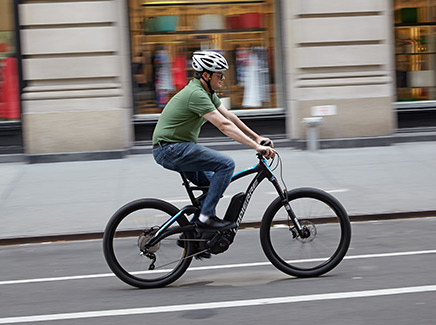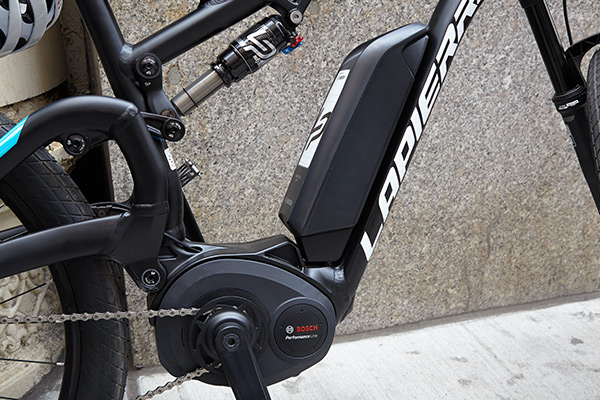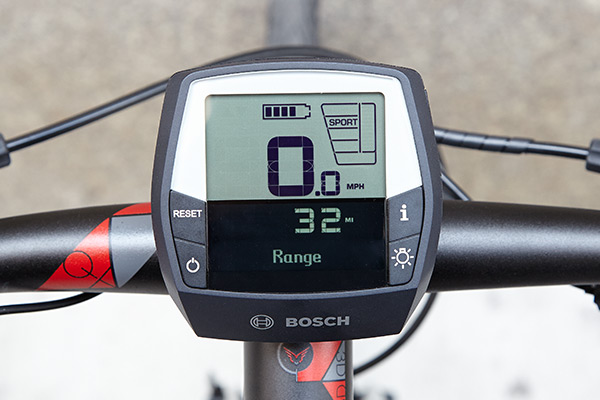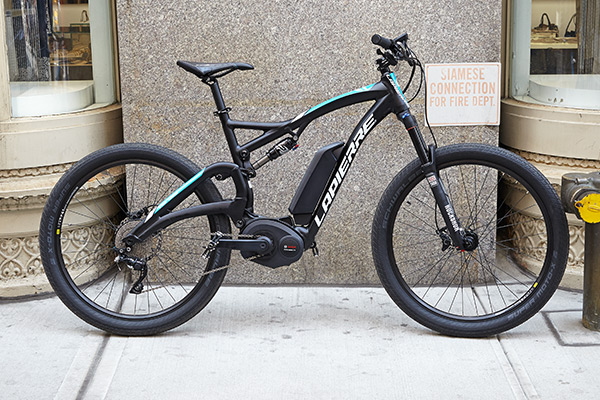Test Riding Bosch's $5,500 eBike: Is it worth it?
Will Bosch's eBikes catch on in the U.S.? I took a ride on one around the streets of Manhattan to find out.

As I rode around New York on a bicycle with Bosch's electric power-assist system, I couldn't help but feel the boost of energy every time I turned the pedals, which helped me zip through traffic like a deranged bike messenger, all without breaking a sweat. But is the avoidance of pit stains enough of a reason to drop more than $4,000 on a bicycle?
Geared for professionals who don't want to change clothes when they get to work, delivery people, older individuals who have trouble getting up hills, or those who simply want to get around more easily, eBikes--those that have an electric motor which either helps turn the wheels or the pedals--have proven popular in Europe and China. eBikes have yet to take off in the U.S., but Bosch believes that will change next year. I took an eBike outfitted with Bosch's system for a ride around Manhattan, to see if it really has legs.
In anticipation of a pedal-powered boom, Bosch, makers of everything from refrigerators to spark plugs, is introducing its electric bicycles to the U.S. market. Unlike some electric bikes that do all the work for you, Bosch's pedal-assist system give riders an extra boost while pedaling, making it easier to ride up hills, for example.
Bosch doesn't sell its eBike system directly to consumers; it comes already built into bikes made by other manufacturers. Currently, Cube, LaPierre, Haibike, Felt Electric, and Xtrabike offer Bosch's system, with Cannondale, Trek, and Scott to come in 2016. But it doesn't come cheap: Haibike, which makes several mountain bikes with Bosch's system, start at around $4,000, which is almost twice as expensive as other bikes with electric assist drives from, say, Panasonic. The LaPierre Overvolt FS 900 mountain bike I rode around the city costs around $5,500.

Bosch's eBike system is composed of three parts: A drive unit, battery pack, and handlebar-mounted controls and display. Riding an eBike around Manhattan, I couldn't help but notice the extra kick provided by the electric motor. It felt as if someone came up behind me and gave me a push. The controls were dead simple to use, too: two buttons on a left controller let me increase or decrease the amount of power being delivered to the drivetrain.
An LCD console mounted in the center of the handlebars showed the range of the battery, distance traveled, and a few other metrics related to the ride. On the right handlebar was a gear shifter, which I used as with any other bike.
MORE: Fitness Tracker Buying Guide

For all the ease of Bosch's system, there's still something very nerve-wracking about riding a bike around Manhattan. Despite using bike lanes, I was constantly dodging delivery trucks, buses, and open taxicab doors. Good thing I was wearing a helmet.
Apart from popularity among cyclists, eBike adoption in the U.S. faces some hurdles. For one, laws regulating their use need to be updated. While federal law distinguishes between low-powered electric bikes--those that can't exceed 20 miles per hour, and which require you to pedal--from mopeds and motorcycles, many state laws have yet to be updated. For example, it's currently illegal to operate any motor-assisted bicycle on any road in the state of New York, according to the New York Department of Motor Vehicles. (A bill to amend the law is currently pending in the state assembly). Bosch says its eBikes don't fall into that category, but it's still a bit of a gray area.

And then there's the cost. With the least expensive eBike from any manufacturer going for around $2,000, it represents a serious investment--and one I'd be hesitant to lock up outdoors for the whole day. But there's no denying that an eBike is effective in helping you get where you need to go, with almost no learning curve. You could almost say it's as easy as riding a bike.
Sign up to get the BEST of Tom's Guide direct to your inbox.
Get instant access to breaking news, the hottest reviews, great deals and helpful tips.

Michael A. Prospero is the U.S. Editor-in-Chief for Tom’s Guide. He oversees all evergreen content and oversees the Homes, Smart Home, and Fitness/Wearables categories for the site. In his spare time, he also tests out the latest drones, electric scooters, and smart home gadgets, such as video doorbells. Before his tenure at Tom's Guide, he was the Reviews Editor for Laptop Magazine, a reporter at Fast Company, the Times of Trenton, and, many eons back, an intern at George magazine. He received his undergraduate degree from Boston College, where he worked on the campus newspaper The Heights, and then attended the Columbia University school of Journalism. When he’s not testing out the latest running watch, electric scooter, or skiing or training for a marathon, he’s probably using the latest sous vide machine, smoker, or pizza oven, to the delight — or chagrin — of his family.
-
HideOut also be aware, in many off road areas, these bikes arn't legal to use. Many have a pure manual only clause so don't plan on doing any real MTB riding with them in many places.Reply -
mfano Why do they cost so much in the states????I have bought a German Pegasus treeking bike with the same system for 2000 Euros....it has hydraulic disk brakes, front suspension, lights..the works. The system works like a dream...Reply -
mfano ReplyOk. How many miles will it go on a charge?
Like anything electric it depends on what setting you use it on ..or the terrain you are riding on. The system has 4 settings Eco, Touring, Sport and Turbo. ECO gives you a 40% boost to your effort..and Turbo 275% help...go on line to bosch and look for Active or Performance line bike pedal assist systems...all your answers will be there...
-
mfano Replyalso be aware, in many off road areas, these bikes arn't legal to use. Many have a pure manual only clause so don't plan on doing any real MTB riding with them in many places.
Wrong!...certain countries have different rules..here in Europe the max is 25KPH then the motor quits..in the US I believe it will be 45KPH before the engine quits. The only difference between the Active and Performance systems is the programming..so if I was to make my active line a Performance line and was caught riding it here in Italy I would be fined.
-
sadsteve Replyalso be aware, in many off road areas, these bikes arn't legal to use. Many have a pure manual only clause so don't plan on doing any real MTB riding with them in many places.
Wrong!...certain countries have different rules..here in Europe the max is 25KPH then the motor quits..in the US I believe it will be 45KPH before the engine quits. The only difference between the Active and Performance systems is the programming..so if I was to make my active line a Performance line and was caught riding it here in Italy I would be fined.
I figured I could go on line to look it up. It was just something I thought would be in the article! Plus a link to the product page would have been handy too. -
mprospero As mfano mentioned, mileage varies depending on the mode. When I had the bike in Eco mode, it gave an estimated range of 100 miles, but in Turbo mode, mileage dropped to below 20.Reply
This bike won't move unless you pedal it, so it's not like it's an electric moped. The motor merely gives you a little boost. To get it up to 45KPH, you'd really have to be cruising on this thing.
As far as legality, it really depends on the municipality. New York state law (where I rode it) doesn't currently distinguish between the two. On the DMV's website, it falls under "motor-assisted bicycle." http://dmv.ny.gov/registration/motorized-devices-cannot-be-registered-new-york.
-
jj463rd http://en.wikipedia.org/wiki/Electric_bicycle_lawsReply
In the United States of America by Federal Law electric bikes are limited to
a maximum electric assist motor speed of 20 mph which is around 32 kph and the top wattage of around 750 watts for the motor rating.State laws vary however as in my particular state (Washington State) 1000 watt motor ratings are allowed to remain legal (say for just an electric motor kit probably not a electric bike as it would be likely under federal laws(750 watts max) to be sold in other states ).
These will become especially popular/nessessary as alternative transportation when petroleum fuels worldwide become depleted/exhorbitantly expensive in the near future like a couple of decades from now.Also electrical energy will become scarce and highly expensive as well since climate change will be devastating to hydoelectric sources (lack of glacial melt to feed them).
.Basically forget electrical energy eating hog electric cars as an alternative in the future in several decades from now unless you will become wealthy enough to afford either them or the immense cost of electricity by then.Replacing fossil fuel large vehicles in their present numbers with electric large vehicles (like passenger cars and trucks) won't be practical because there won't be the electricity worldwide to power them.
The worldwide adoption of high power efficiency (like 900 MPGe to 1,800 MPGe) electric bicycles would however likely be practical.Also they are are more limited in range so the overall power usage would be far less than any electric car.
.. -
aldaia No wonder eBikes are not very popular in the US. $4000 is a rip-off, my wife has a foldable e-bike with similar characteristics (ideal for moving around the citty) that she got for about $700.Reply
